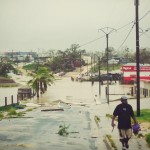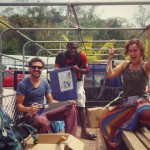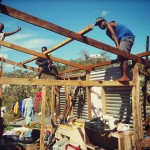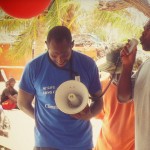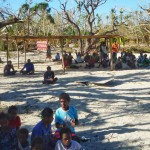[dropcap]A[/dropcap] month on from Tropical Cyclone Pam’s decimation of the South Pacific nation of Vanuatu, tens of thousands of people still face dire food and water shortages, and thousands remain homeless as they wait for sufficient aid to reach them.
Vanuatu is composed of a sprawling set of 83 islands and 260,000 people, situated 2,000 km (1,250 miles) northeast of the Australian city of Brisbane.
“The windows were shaking and the door started shaking madly, and…the air pressure was changing – I had to pop my ears. Because the wind was just throttling through there so quickly.”
Cyclone Pam tore across the archipelago on the evening of Friday March 13 and into the following day, battering 22 of the nation’s islands with fierce winds of up to 300 kph (185 mph), torrential rain, and massive storm surges.
Twenty-five-year-old Australian Sophie Wilksch and her German partner Steffen Müller were holidaying in Vanuatu at the time and rode out the storm inside a motel in the capital, Port Vila.
“This really loud howling wind…it was just picking up and picking up through the night…and the rain started coming in through the louvers.
“We got really scared so we packed our bags and sat in the corner of the room, close to the door, so if the roof went off we could run out…and we just sat there with our backpacks while this room was flooding.
“The windows were shaking and the door started shaking madly, and…the air pressure was changing – I had to pop my ears. Because the wind was just throttling through there so quickly,” Ms Wilksch said.
The category five cyclone was one of the worst storms ever to hit the South Pacific, washing away roads and bridges, destroying many homes and schools, and killing at least 11 people.
“It was crazy, the devastation. It was just a huge mess. It was just amazing how much destruction there was.
“There were quite a few huge trees right next to our motel and they were just gone. And then all of the leaves off the [remaining] trees were just gone…And because of that, you could see all the damage that’s happened to the houses, like many of the roofs had blown off,” Ms Wilksch said.
The UN says as much as 90 per cent of crops were uprooted in the cyclone’s path, and tens of thousands of people still do not have access to safe drinking water. It is estimated that almost 60,000 people do not have sufficient food.
Repairing and Rebuilding
Having graduated from architecture at the University of South Australia, and earned her living thus far doing building and carpentry work in the New South Wales beachside town of Byron Bay, Ms Wilksch decided not to return immediately to Australia, but to stay in Vanuatu and put her skills to good use.
“Since I studied architecture at uni I’ve been doing carpentry work and building work, and my partner Steffen is a cabinet maker…so we thought we’d better help these guys out,” she said.
The couple were putting roofs and gutters on houses, fixing doors, repairing walls, clearing pathways, sourcing tarpaulins, and more – all while raising money from family and friends in Australia and Germany to make it happen.
“A few days after [the cyclone], we’d managed to raise about $2,500 and bought as much flour, rice, sugar, salt and medical supplies as we could. And then just building supplies really; hammers and saws, roofing nails, roofing tape, and all sorts of tools,” she said.
The two ended up raising around $4,500 altogether which all went to fixing homes and gathering supplies mainly for the community on the small island of Pele, a half-hour boat ride from the main island of Efate.
Ms Wilksch said the locals rallied together and worked hard every day to achieve as much as possible.
“One guy Reuben, he just ended up working with us every day. He’d come to us in the morning and he’d say ‘What are we doing today?’ and then he’d work with us all day until we’d finish. And he’d bring us lunch, and he’d bring us dinner, and they really looked after us, even though they could only feed us rice and a few other things.
“The locals helped so much, and the women and children work like the men…And people were, they were so thankful. They were just so thankful all of the time,” she said.
Aid Bottleneck
While emergency relief has flowed to many in need, for too many it has taken too long to arrive, and some still have not seen enough of the aid they are so desperately looking for.
Authorities in Vanuatu say 70 percent of the country’s population has been displaced by Cyclone Pam and the emergency is not yet over with relief agencies saying conditions were among the most challenging they have experienced.
Around 166,000 people have been affected by Tropical Cyclone Pam on 22 islands, and food stocks and water reserves are being exhausted.
“When we got to Pele, we got there five days after the cyclone, and we were the first help to arrive. And they had no food, they had no fruit left, they had 10 houses left out of 45, and they were getting pretty worried about having any fresh water to drink.”
Ms Wilksch expressed concern that the aid money and supplies haven’t been getting through to the right people in adequate time.
“When we got to Pele, we got there five days after the cyclone, and we were the first help to arrive. And they had no food, they had no fruit left, they had 10 houses left out of 45 and they were getting pretty worried about having any fresh water to drink…We were the only people who were there.
“The military came with some supplies I think four days after we got there, which was over a week after the cyclone hit…The Red Cross got there almost two weeks after the cyclone,” she said.
Ms Wilksch also observed that once the aid did arrive, the way it was distributed appeared to create some division within the community.
“The Red Cross did come, but they said they had to choose out of the 35 families that completely lost homes they had to choose 20 that the Red Cross would support. And those 20 people got a hygiene kit…they got a tarpaulin, a sleeping mat, and a shovel, and saws, and hammers, and a few nails and stuff.
“But the fact that the community had to choose 20 families out of the 35…it created a bit of a bad feeling within the community…And the fact that they’d arrived a week and a half, two weeks late. Everyone was a bit disappointed,” she said.
– The Red Cross has been contacted by Circus Bazaar for comment on the current aid situation in Vanuatu.
Long-term Impact
Vanuatu risks long-term food insecurity after Cyclone Pam destroyed banana, coconut and other crops, killed livestock, and wrecked boats and fishing canoes.
The U.N. and partner NGOs have started to provide families with seed kits to ensure food security into the future, and will support the government in restoring infrastructure and reviving economic activities.
– Donate to the Vanuatu relief effort: Red Cross – Unicef – Care – Child Fund – Oxfam
However, most of the population depends on subsistence agriculture and aid agencies say it could take up to a year for communities to become self-sufficient once more
Ms Wilksch said she could see that the long-term impact of Cyclone Pam on Pele Island would be strongly felt.
“The long term problems for them are pretty bad because their main income is from selling fruit at the markets, and now that their fruit trees have been wiped out…The quickest ones to return will be the banana trees which will take months. Others will take years,” she said.
“But at the same time, the strength and resilience of these people is inspiring. These guys are so resilient, they’re so amazing. They just do what they can to survive.”





















